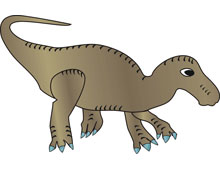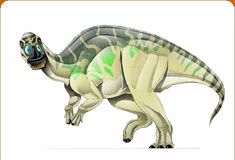 By Peter
By Peter(This post is really a continuation of this post on my blog.)
What does correct palaeoart look like? Is it Sir Charles Knight's pencils or Luis V. Rey's colourful paint? How can you capture what an animal nobody has ever seen before looks like?
This is the basic problem that artists face when reconstructing extinct animals and plants. Interpreting skeletal material, skin impressions, and footprints, they try to create life! This is not an easy job. Mistakes are made, evidence is reinterpreted, ideas and theories change. As ideas change, so must palaeoart.
In a previous post on Bond's Blog, I took the example of Minmi paravertebra and discovered a huge range of reconstructions of this small dinosaur (even with over 95% of the skeleton found!) I would understand such variation in reconstruction for creatures such as Deinocheirus, where we have only found its arms. But for a well known extinct animal, why is there such variation in our reconstructions of it?
For example, I have searched the net for photos of another well known dinosaur: Edmontosaurus regalis.















Skull length, neck length, arm length and positioning, muscle thickness and placement, feet and hand differences, even body pose... This variety in anatomy mixed with the subjective colour and texture amounts to a series of pictures that look like different animals.
Is one reconstruction better than others? What does "better" mean? If we equate "better" with "more accurate," then yes, some are more accurate than others. Accuracy comes with time, new discoveries and new ideas. Is the goal of a palaeoartist to be as accurate as possible?
What are the goals of a palaeoartist? Leave your comments below!
Artist Credits:
1. Charles R. Knight (at the Chicago Field Museum of Natural History)
2. Karen Carr (2008 Dinosaur Society Hadrosaur)
3. Charles R. Knight (1897 Hadrosaurus from Century Magazine)
4. Joseph Smit (1905 Hadrosaurus from Nebula to Man)
5. Rudolph Zallinger (from the Age of Reptiles at Peabody Museum)
6. Dorling Kindersley (with DK images)
7. Unknown artist (from In Hand Museum.com)
8. Neil Riehle (2000 Edmontosaurus)
9. Unknown artist (Edmontosaurus from KidsFront)
10. Unknown artist (for the National Geographic Society)
11. Unknown artist (from the Jurassic Park Institute)
12. Unknown artist (Edmontosaurus from Urwelt Museum Neiderhell in Germany)
13. Joe Tucciarone
14. Todd Marshal (Edmontosaurus annectens)
15. Mineo Shiraishi
16. Micheal Berglund (for Bob Bakker and the Huston Museum of Natural Science)
